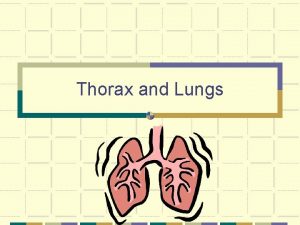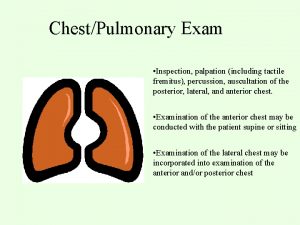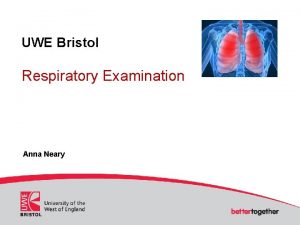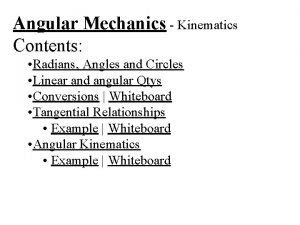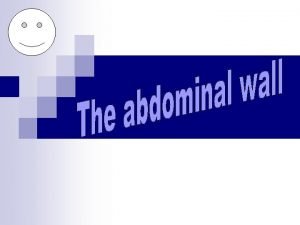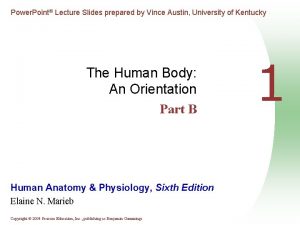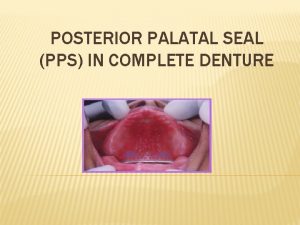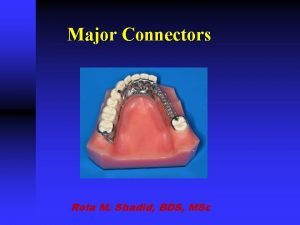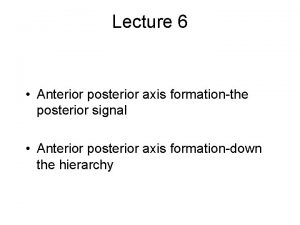Image Analysis Anterior Posterior Chest Projection RAD 438

















- Slides: 17

Image Analysis Anterior Posterior Chest Projection RAD 438 LESLIE LYLE

The Suboptimal AP Chest

Image Analysis Criteria �Patient Demographics �Radiation Protection �Marker Placement �Artifacts �Anatomical Position & �Image Corrections Placement �Anatomical Relationships �Recorded Detail �Image Contrast & Density �Histogram �AP Chest Projection Analysis Criteria �Optimal Image with Anatomy

Patient Demographics �Patient name �Patient Date of Birth (DOB) �Facility name �Date & Time of Exam �Identification Plate (Barcode) �Degree of Patient Elevation v. No Patient Demographics are present on image.

Marker Placement � Correct side of patient is marked � Marker does not cover any area of interest. � Marker is positioned away from the center of the image. � In this image the right marker was annotated on a computer after the image was taken. A lead marker should be used to allow image to be legal in a court of law. � Lead markers with BBs can be used to show patient elevation.

Anatomical Position & Placement �Required anatomical structures are visible on image with the exception of apices. �Correct image receptor size was used. �IR was correctly placed behind patient in a crosswise position. �Proper collimation around the area of interest is present. Collimation is within 0. 5 inch of the patient’s skin line.

Anatomical Relationships � Cephalic central ray angulation has projected clavicles up. less than 1 inch of apical lung is visible. � Manubrium is superimposed over the 2 nd thoracic vertebra. Should be over 4 th. � Left sternal clavicular end is projected farther away from manubrium than the right Patient is rotated.

Anatomical Relationships Cont… �The 7 th thoracic vertebra is at the center of the collimation field. �The scapula are demonstrated within the lung field. Shoulders should be rolled forward. � 10 posterior ribs are demonstrated above the diaphragm indicating full inspiration.

Recorded Detail �Correct SID used �Patient’s back was against image receptor. �No motion or respiration errors present �No double-exposure �Image receptor was crosswise �Sufficient recorded detail present. v. Lung markings, diaphragm, heart borders, costophrenic angles, hilum, apices, cortical outlines are seen.

Image Contrast & Density �Both lungs from apices to �No image fog costophrenic angles are demonstrated �OID at a minimum �Appropriate SID �Correct receptor system �Adequate k. Vp & m. As used �Low subject contrast �Appropriate scale of contrast �Correct collimation �No quantum noise demonstrated v. Adequate contrast and density are present.

Histogram • • Histogram below is example chest histogram. X-axis is pixel values Y-axis is brightness value Histogram analysis errors will cause image quality to decrease, similar to images with exposure errors. • Peaks and valley represent subject contrast. • Incorrect histograms cause exposure indicator errors.

Radiation Protection �ALARA (as low as reasonably achievable) should always be used. �Explain exam to patient in clear concise instructions �Use immobilization devices when necessary �Use tape measure to obtain appropriate SID �Collimate field size tightly �Use compensating filter if needed None used for this exam �Set exposure factors to minimize patient exposure �Shield patient appropriately with use of lead shield for males and females �No anatomical artifacts present

Artifacts �Heart monitor leads have been shifted mostly out of the area of interest. �No artifacts related to poor film or poor phosphor plate handling are present. �No anatomic artifacts (artifacts that can be removed) are present.

Image Corrections �Central Ray needs to be aligned caudally until it is perpendicular to midcoronal plane. �To decrease slight patient rotation, rotate patient slightly to the right or adjust central ray perpendicular to image receptor. �Lead marker should be used to mark correct side. �Degree of patient elevation should be annotated. If patient is in ICU SID and technical factors should be included as well �Patient demographics should be visible.

AP Chest Projection Analysis Criteria � Date, time, SID used, patient elevation, and technical factors are recorded on image. � 7 th thoracic vertebra is at the center of the image. � Both lungs are fully visible within the collimated field. � Sternal clavicular ends are equal distances from the vertebral columns & the lengths of left and right posterior ribs are equal. � The 4 th thoracic vertebra is superimposed by the manubrium � 1 inch of the apical lung field is visible above the clavicles. � Scapulae are outside the lung field. � Posterior ribs demonstrate a gentle cephalically bowed contour. � 9 – 10 posterior ribs are visualized above the diaphragm.

Optimal AP Chest with Anatomy

References � Digital Radiographic Image Processing and Manipulation. (2016, December 06). Retrieved April 13, 2016, from http: //clinicalgate. com/digitalradiographic-image-processingand-manipulation/ � Mc. Quillen-Martensen, K. (2011). Radiographic image analysis (3 rd ed. ). St. Louis, MO: Saunders/Elsevier.
 Thoracic configuration
Thoracic configuration Tactile fremitus
Tactile fremitus Fremitus lungs
Fremitus lungs Sitting duck heart persistent truncus arteriosus
Sitting duck heart persistent truncus arteriosus Posterior thorax lecture
Posterior thorax lecture Tactile fremitis
Tactile fremitis Fluke 438 series analyzer
Fluke 438 series analyzer Cs438 uiuc
Cs438 uiuc Biba n 467 ddl
Biba n 467 ddl 438 days
438 days Tbk 438/3 haksız fesih tazminatı
Tbk 438/3 haksız fesih tazminatı 72 rpm to rad/s
72 rpm to rad/s Anterior stroke vs posterior stroke
Anterior stroke vs posterior stroke Erect body position
Erect body position Oblique inguinal hernia
Oblique inguinal hernia The anterior and posterior body cavities
The anterior and posterior body cavities Palatal seal
Palatal seal Horseshoe palatal connector
Horseshoe palatal connector
